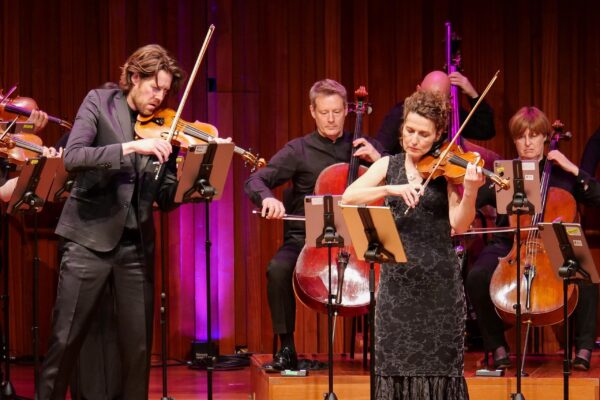 United Kingdom Various, Britten Sinfonia’s Musical Everests: Thomas Gould (violin/director), Miranda Dale (violin), Caroline Dearnley (cello) / Agata Zajac (conductor; only for the Maconchy). Milton Court Concert Hall, London. 24.5.2023. (JC)
United Kingdom Various, Britten Sinfonia’s Musical Everests: Thomas Gould (violin/director), Miranda Dale (violin), Caroline Dearnley (cello) / Agata Zajac (conductor; only for the Maconchy). Milton Court Concert Hall, London. 24.5.2023. (JC)

Corelli – Concerto Grosso, Op.6, No.2
Tippett – Fantasia Concertante on a theme of Corelli
Elizabeth Maconchy – Symphony for Double String Orchestra
Joseph Phibbs – Flame and Shadow
Walton – Finale from Variations on an Elizabethan Theme
Britten Sinfonia once again delivered a spectacular concert which was a mixture of innovative programming and exciting playing (them being a large conductor-less ensemble, artistic director Meurig Bowen has deemed it ‘extreme chamber music’, an apt description to say the least). Titled ‘Musical Everests: The Year 1953’, the programme mostly included works written in 1953, a significant year which marked the late Queen’s coronation as well as the scaling of Mount Everest. The Britten Sinfonia chose two pieces written for the Aldeburgh Festival of that year, Tippett’s large-scale Corelli Fantasia and Walton’s brief yet exuberant finale from Variations on an Elizabethan Theme. Another 1953 composition excluded from the Aldeburgh line-up was also programmed: Elizabeth Machoncy’s Symphony for Double String Orchestra, while Joseph Phibbs’s Flame and Shadow, written for Britten Sinfonia this year, continues its world premiere tour at Milton Court Concert Hall.
If thirty iPads onstage attached to stands, glowing softly as they await the players, seemed a slightly eerie and jarring sight, the playing which followed as soon as the performers stepped into the spotlight was anything but. The Corelli Concerto Grosso in F major which opened the concert was played elegantly and gracefully, with a wonderful sense of communication between the concertino section (the small group of soloists), but it was programming this Concerto Grosso right before the Tippett Fantasia, which takes musical material from that concerto as its starting point, that really revealed the engaging conversation between two great composers across centuries and cultures. Having heard the Corelli immediately before, we could see how Tippett pays homage to the Baroque style and then gradually shifting towards his own musical language. In the performance of the Tippett, I felt as if I had wandered through musical time without having realised it until the original theme returned. This type of programming – pairing a piece of contemporary music with its Baroque muse – works well in highlighting the unique characteristics of both pieces. One must also applaud Thomas Gould for his energetic direction, which always seemed calm and encouraging even as the ensemble navigated the tricky fugue in the middle of the Tippett Fantasia.
In the second half the Britten Sinfonia demonstrated their ability of introducing obscure pieces to their audience by bringing Machoncy’s Symphony for Double String Orchestra to the table which, as Bowen admitted, none of the players had played before and had also to read from a handwritten score. Yet it was convincingly presented and offered a wonderful introduction to an exciting piece with much substance. I was completely taken from the jolting opening to the very end by the riveting rhythms and counterpoint which kept my ears perked up throughout all four movements. Not to mention how difficult it was to navigate tricky rhythms with a double string orchestra! Credit must be given to Agata Zajac, called in especially for this occasion in order to help guide the ensemble through the incredibly complicated music, so that the Britten Sinfonia might deliver as convincing a performance of this little-known piece as possible, and to vouch for its reputation.
Machoncy’s Symphony was followed by Joseph Phibbs’s Flame and Shadow, a piece in four short movements that takes its title from that of a verse collection by American poet Sara Teasdale, but which takes more of its musical inspiration – as the composer told us – from the string writing of Frank Bridge and Benjamin Britten. If Machoncy’s symphony is a study in rhythm, then Phibbs’s composition is a study in texture. I was taken by how realistically Phibbs evoked the hum of neon lights in the aptly titled first movement ‘Neon’, and the sound created by the string ensemble, with its shimmering texture, demonstrated how well acquainted Phibbs is with the ensemble’s textural capabilities. In fact, I believe it is this play with texture that makes the title of the composition fitting – the constant flitting between light and darkness in a rather humorous way.
Finally, the Britten Sinfonia put us all in a jubilant mood by finishing the concert with a brilliant finale from Walton’s Variations, rounding off an evening of joyful discoveries and lively musical conversations across the centuries.
Jeremy Chan
